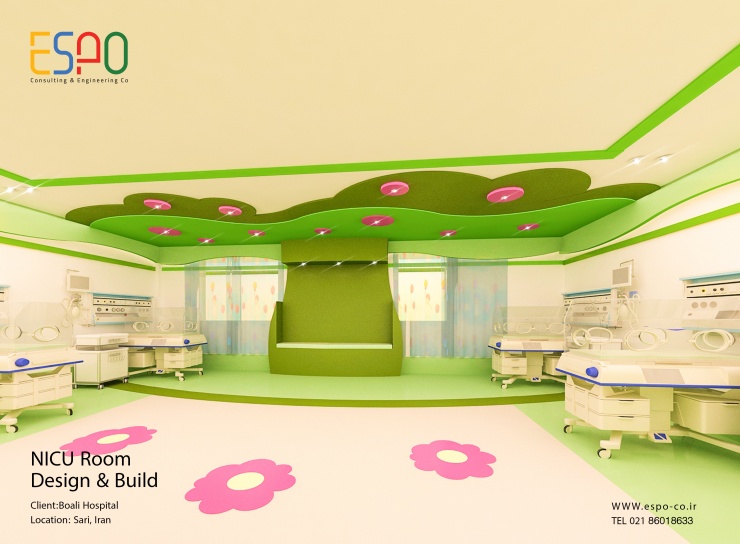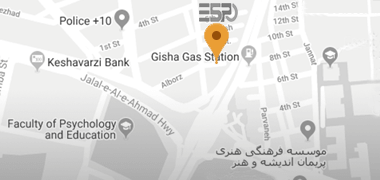
بخش NICU (Neonatal Intensive Care Unit) یا بخش مراقبتهای ویژه نوزادان، یکی از حساسترین و حیاتیترین بخشهای بیمارستان است. این بخش برای نوزادانی طراحی شده است که نیاز به مراقبتهای تخصصی و ویژه دارند؛ نوزادانی که دچار مشکلات تنفسی، نارسایی اندامها، وزن پایین، و یا سایر بیماریهای خطرناک هستند. در NICU، تجهیزات پیشرفته پزشکی و تیمی از متخصصین از جمله پزشکان، پرستاران و تکنسینها به مراقبت 24 ساعته از این نوزادان مشغولاند. الزامات و نکات طراحی بخش NICU: طراحی این بخش نیازمند توجه به جزئیات و استانداردهای خاصی است تا هم برای نوزادان و هم برای کادر درمانی محیطی ایمن و بهینه فراهم شود.
1. فضا و دسترسی مناسب: فضا باید به گونهای طراحی شود که دسترسی به تجهیزات و بیماران راحت باشد. همچنین هر نوزاد باید فضای کافی داشته باشد تا بتوان در مواقع لزوم به سرعت اقدامات لازم را انجام داد.
2. کنترل صدا و نور: نوزادان در بخش NICU به شدت به صدا و نور حساس هستند. طراحی این بخش باید به گونهای باشد که صداها به حداقل رسیده و نورهای مصنوعی کنترل شده باشند تا از آسیب به نوزادان جلوگیری شود.
3. سیستم تهویه و کنترل عفونت: نوزادان در این بخش با سیستم ایمنی ضعیفی به دنیا میآیند. بنابراین، تهویه هوا و کنترل عفونتها از مهمترین مسائلی است که باید در طراحی در نظر گرفته شود. استفاده از سیستمهای فیلتراسیون پیشرفته و تهویه با کنترل دقیق میتواند خطر عفونتها را به شدت کاهش دهد.
4. تجهیزات پیشرفته و دسترسی به فناوری: تجهیزات پیشرفته پزشکی از قبیل دستگاههای مانیتورینگ، دستگاههای کمک تنفسی و انکوباتورها باید بهطور یکپارچه در بخش نصب شده و به آسانی در دسترس باشند. همچنین این تجهیزات باید به راحتی تعمیر و نگهداری شوند.
5. فضاهای پشتیبانی و استراحت برای والدین: از آنجا که والدین نیز بهطور مستقیم در مراقبت و همراهی نوزادان خود نقش دارند، طراحی بخشهایی برای استراحت والدین و فضایی که بتوانند در کنار نوزاد خود باشند از اهمیت زیادی برخوردار است.
6. رنگ و مواد مورد استفاده: انتخاب رنگها و مواد استفاده شده در دیوارها، کفها و سقفها نیز از اهمیت ویژهای برخوردار است. رنگها باید آرامشبخش باشند و مواد باید ضدعفونیشونده و مقاوم در برابر باکتریها باشند.
شرکت اسپو با سالها تجربه در زمینه مهندسی و معماری، افتخار دارد که در طراحی و اجرای بخشهای حیاتی بیمارستانی از جمله بخش NICU، خدمات حرفهای و استانداردهای جهانی ارائه دهد. تیم ما شامل متخصصین معماری، مهندسی، و پزشکی است که با همکاری نزدیک، نیازهای منحصر بهفرد هر بیمارستان را تحلیل کرده و طرحهایی منحصربهفرد و کاربردی ارائه میدهند. ما از مرحلهی طراحی مفهومی تا اجرای نهایی، با استفاده از تکنولوژیهای مدرن و بهروزترین متدهای مهندسی، پروژههای بیمارستانی را به گونهای به انجام میرسانیم که تضمینکنندهی ایمنی، کارایی و راحتی برای تمامی کاربران باشد. اگر به دنبال ایجاد یک محیط تخصصی و بهینه برای مراقبت از نوزادان هستید، شرکت ما آماده است تا راهحلهای مهندسی و معماری دقیق و علمی را برای شما فراهم کند.










